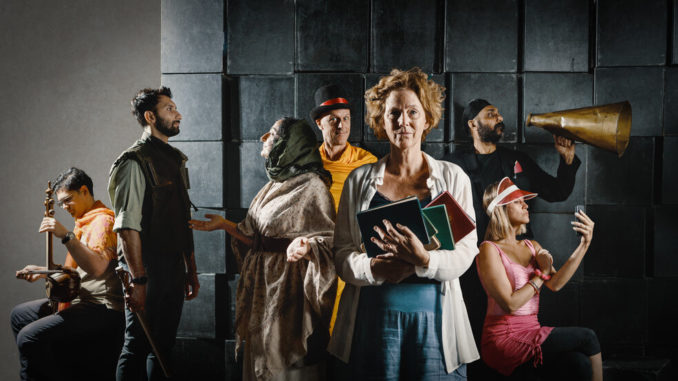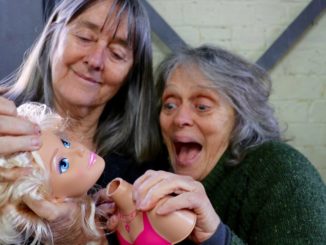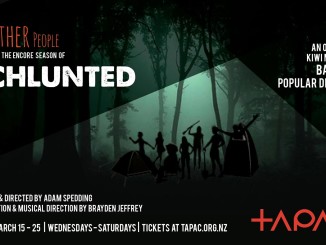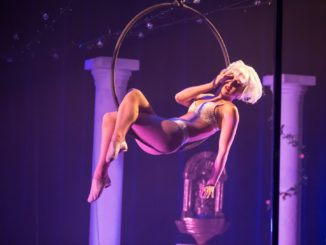
[The Walls That Divide Us]
Billed as a ‘kaleidoscopic tale about migrant experience and reactions to migration’, The Wall is an original, devised production based on real stories that aims to open questions about identity, unconscious bias and the state of the world. Written by Mallika Krishnamurthy and directed by Daniel Fernandez from Babel Theatre, The Wall involves a large racially diverse cast of over twenty-five (Abigail Cerecke, Adriana Yianacou, Ann Gerstenmeir, Anne-Sophie Musset, Carlos Celis, Catherine Maunsell, Cristina Anaid Alvarado Useche, Daniel Fernandez, Dario Kuprienko, Isabella Pezza, Isabelle Cohen, Itai Biran, Karina Kokonut, Keven Souza, Léon Bristow, Manali Bhatia, Marcos Weht, Maulik Thakkar, Natasha Díaz, Puru Bakshi, Raj Singh, Rishabh Kapoor, Shahab Ramhormozian, Sneha Shetty and Vanja Major). The audience in attendance on opening night is seemingly just as diverse.
The show begins with an announcement in an array of different languages, telling audiences to ‘please turn off your phone’. Two musicians proceed to enter the stage, one playing an accordion and the other a kamancheh (an Iranian bow stringed instrument). A white female writer emerges from under a pile of newspapers surrounded by stacks of books, and begins to ask with desperation and concern: ‘And whose story am I telling?’ Two migrants reply, ‘You have to tell both our stories, and all the ones in-between’. A group segment follows, where six actors start folding clothes, each repeating a different phrase in English and other languages: ‘Forty minutes and it’s time to go’, ‘there is no opportunity here’, ‘my brother was promised a job’. The migrants gather, and are about to enter their new host country, who welcomes them with the words: ‘we are the most powerful city in the world’.
The first migrant who shares his experience tells of his pain of not being seen: ‘I get to the front of the queue, and she looks straight through me; she serves the person behind me’. The show alternatives between group segments, monologues, and dramatized versions of situations in which migrants experience discrimination. There is Norberto, whom a migrants housing inspection officer keeps on calling ‘Roberto’; she enquires about his new job at the petrol station, with his wife exclaiming, ‘but he’s an engineer!’. A scene at the wall shows a powerful politician exclaiming: ‘Do we really need these ways here? Foreign ways? Or do we preserve what makes us great? If they are not prepared to accept our values, I suggest you go back to where you came from’.
Multiple layers are added to this production, these include the friendly interaction between two guards on opposite sides of the wall/border crossing, as well as the appearance of two female western tourists. Their appearance, dressed in pink clothes and make-up, remind me of ‘disaster tourism’ or the show Dark Tourist in which people pay to go on a trek to experience the kind of border crossing an illegal immigrant may be forced to endure. The two women are there as ‘voyeurs’ at the border – excuse me, we have tickets. Is this The Wall?’ – wanting to receive an ‘authentic experience’ of what it would be like to be a ‘real traveller’ at a border crossing. The presence of the two women becomes a critique of how culture becomes something to be ‘consumed’, without any real engagement. The engagement with others who are different is only performed at a surface and superficial level, without any real understanding.
I thought that the strength of this show was in the group scenes, which included freeze frames, the use of spotlight and alternating monologues. These were well executed and provided some comedic moments. I left the show though, with some thoughts in mind. I wondered whether a more nuanced exploration regarding racial politics may have added to the discussion. These included the role of the white female writer, who seems to be assigned as a ‘vessel’ to receive and document the migrant’s stories, as well as being the one who acknowledges them: ‘I see you’ she says to the man who was ignored. My companion and I wondered whether this could potentially be problematic, as even if she was a migrant herself, the experiences and subjectivities of the others would be ‘filtered’ through a white lens. There are also varied nuances and tensions between migrant groups and people from the host country, as well as amongst the different migrant groups themselves such as between illegal and legal ones, and I was left thinking whether the show had lumped people together into an ‘us’ versus ‘them’ binary (as symbolised at the end of the show when all the migrants stood together on one side, and those from the host country on the other). All in all, The Wall is a well-executed production raising some big questions about discrimination, and I enjoyed the multiple and varied segments, the theatrical devices used in the group scenes, and the diversity of the cast and creatives involved.
The Wall plays at TAPAC as part of Auckland Fringe 3-7 March, 2020.




Leave a Reply